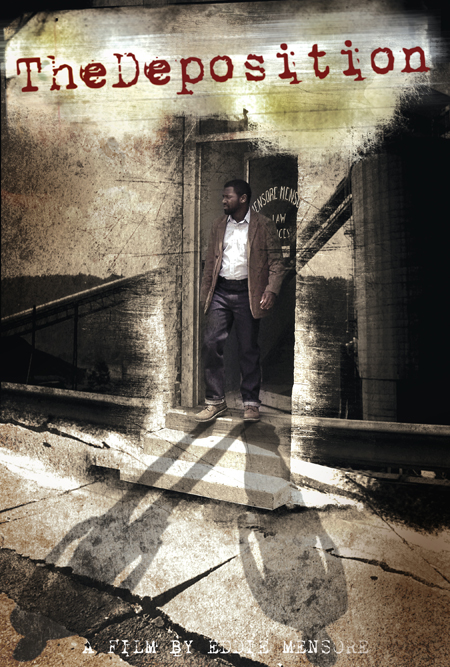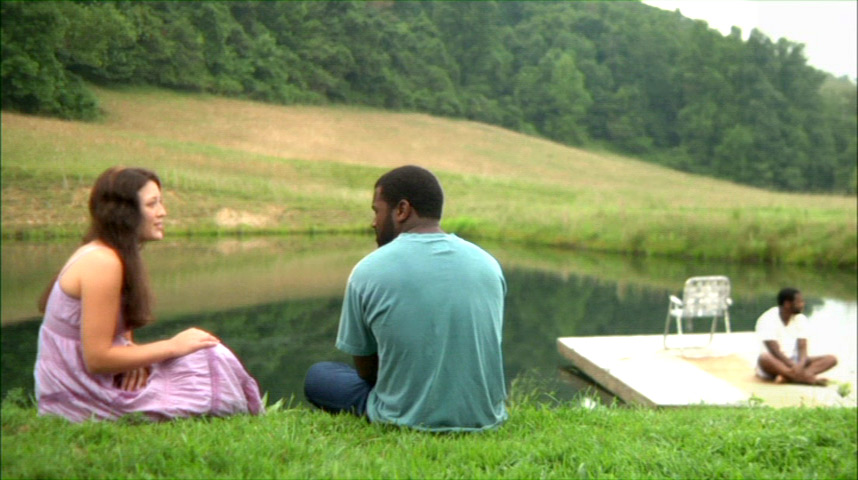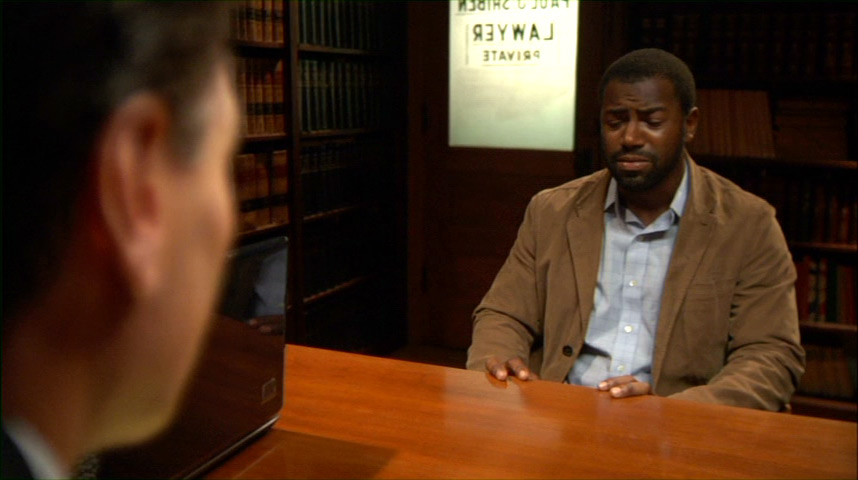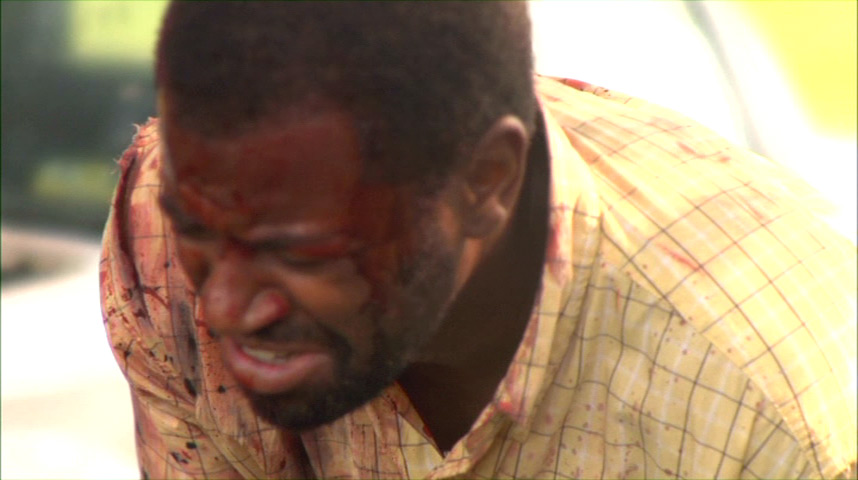Feature Film Critique
The Deposition
 Director: Edward R. Mensore
Director: Edward R. Mensore
Expected Rating: PG-13 due to violent imagery, including suicide, homicide, and lynching
Distribution: Vanguard Cinema
Budget: $28,000
Genre: Drama/Thriller
Release Date: July 2011
Official Website: http://www.thedepositionmovie.com
Trailer: http://www.imdb.com/title/tt1510936/
Running Time: 80 minutes
Critique Issue: #76 (06/12)
Critiqued By: Jeremy Hanke
Final Score: 9.0 out of 10
In a small West Virginia town, on-again off-again lovers Adam Long (Charles Rashard) and Jill Dotey (Rachel Forbes) leave a wedding reception to be reunited in a passionate drive. Unfortunately, when a chaotic series of events leads to an accident, Jill is killed in the wreck and Adam is left doubting his own memories.
As Adam has to try to recount what happened that night for a formal deposition, massive differences surface between his memories and the testimonies of others. Already plagued by mental issues and anger problems, he finds himself wondering if he’s going crazy as he’s assaulted by visions of his own self loathing, the ghost of his ex-girlfriend, and dreams of suicide. At the same time, he must continue trying to work a normal job in the midst of a racially charged West Virginia town that seems to have already convicted him of rage-induced manslaughter.
Content
 The overall writing of this film is intriguing. It’s highly cerebral and subjective, leaving you connected more to the experiences that the main character feels like he is going through than the event itself. To further reinforce this, visions of Jill encourage him to get himself right or to kill himself, while alternate versions of himself tell him to kill others in the town or encourage him to be afraid of the truth.
The overall writing of this film is intriguing. It’s highly cerebral and subjective, leaving you connected more to the experiences that the main character feels like he is going through than the event itself. To further reinforce this, visions of Jill encourage him to get himself right or to kill himself, while alternate versions of himself tell him to kill others in the town or encourage him to be afraid of the truth.
The acting of main characters Charles Rashard and Rachel Forbes is quite good, which really helps make the story compelling. With that said, the actual acting of a number of the secondary characters is a bit stilted. However, the editing by writer/director Edward Mensore, with its highly introspective style, helps bypass most of these issues, as Adam is far more the center of what we’re dealing with than most of the town’s people are.
Warning! Spoiler Alert
The ending for The Deposition is strange in many ways, but yet strangely fitting by the time you arrive at it. It’s not unlike the comment from The Matrix when Neo is challenged to bend a spoon with his mind by a shaved headed mystic. When he’s unsuccessful, the boy confides that Neo simply doesn’t know the secret, which is “that there is no spoon.”
I will confess that I’m not a huge fan of films that you can’t accurately state what the storyline was once you’ve completed it. Usually they’re the result of lazy scriptwriting that uses open-endeness as an excuse or a crutch. (Even movies like “Inception” have a fairly linear story, although their endings leaves a lot of open questions.)
With that said, for some reason, The Deposition worked for me. By the end, the story of what actually happened really isn’t nearly as important as understanding what it must be like go through this madness from the perspective of the main character. It asks what it’s like to feel like you’re going crazy and to feel persecuted, either because of your past, or your race, or your own demons. To make these points, numerous scenes unfold throughout the film of Adam committing suicide, Adam killing people, Adam beating Jill, Adam being tender with Jill, Adam being killed, Adam defending himself by killing people, and alternative versions of the wreck that starts off the movie. Whether any of these happened or are just his own fears, we don’t fully know and later scenes don’t seem to give us definitive clues. This should’ve driven me crazy as a film watcher, yet, for some reason, it intrigued more than it frustrated, which is pretty high praise from me!
Visual Look
Director of Photography Matthew Boyd did an amazing job with this film. The imagery for this film is really lovely and was captured via a Panasonic HVX200 with a 35mm lens adapter, which allowed the camera operator to really get some great selective depth of field shots. (Having shot my last film with a similar rig, I personally appreciated the amount of creativity the Deposition team achieved.) Many of the shots had a lot of dynamic movement through the skill of steadicam operator Jon Edwards. (As this particular rig is especially heavy in comparison to many Indie film rigs, I completely understand why the use of the full Steadicam rig was needed!)
In addition to running the steadicam, Edwards was the gaffer on the film and his skill deserves praise in this respect, as overall use of lighting was quite good in this film. This is especially noticeable in films with a wide depth of skin colors, from very dark to very light (such as that seen between the two protagonists), since digital video is notoriously shallow in terms of the amount of lattitude it has in light sensitivity. (Adjust for a dark subject and a light subject becomes a ghost; adjust for a light subject and a dark subject becomes a shadow.) As such, appropriately exposing people in these extremes really takes a deft hand from the gaffer! Additionally, they were able to deal with these issues in numerous night scenes, which are even more complex because the 35mm lens adapter robs the HVX200 of additional light sensitivity. (Plus the HVX is not the most light sensitive HD camera on the planet, anyway.)
VFX Supervisor Anaitte Vaccaro helped ensure that the use of special effects was effective and meaningful, from the dynamic practical effects found in the crash, to surreal freeze frame effects of the crash done in post, to blended shots featuring Adam’s memories of the past as he is driving down the road at night. Perhaps one of the most well done effects in the film was the use of various dopplegangers of Adam to show his different schisming perceptions and personalities. They were so well done that, at first, I almost wondered if they’d cast an actor who had a twin brother for this purpose!

Subtle camera shots and composites, like this multishot, reveal the mental instability of the protagonist.
Use of Audio
Score creator and sound supervisor Chris Ridenhour did a really impressive job in this film. The music is quite striking and the sound design is quite good, which is especially important due to the tone and feel of the film. One of the common themes woven throughout the sound design were a reverberating montage of people screaming and Adam fighting against his own madness verbally.
While the specific sound effects in general were quite nice, from the crunch of the car crash early on to the sound of an axe chopping into flesh later, I was especially impressed by the use of flesh based punching sound effects during a fist fight between Adam and another character midway through the film. These types of effects are especially hard to get to sound right on a low budget! (I know, because we spent a lot time in a foley stage trying to get similar sounds and it was really tough!)
The dialogue was recorded well, but, at times, they would use the sound of Adam talking—which was intentionally out of sync with the picture—as a form of pseudo-narration. This felt extremely odd and much more like a mistake than an intentional effect. To make this feel more intentional, I would suggest re-recording these segments with a closer, studio microphone, with more of the bass retained and perhaps a bit of added reverb to more readily show this being his inner voice.
Use of Budget
Considering how much time and work had to have gone into this film, the budget is quite good. $19K was spent on the main filming and effects. An additional $9K went into color grading for both the film and effects, as well as to festival entries. While we don’t include festival entries as part of the normal budget, this wasn’t separated in the entry and the final total is still well within our cap! All told, this is really an impressive use of budget!
Lasting Appeal
The lasting appeal of this film is really hard to gauge. I definitely would be open to rewatching the film myself and to showing other people this film. With that said, its rewatchability is both enhanced and limited by how open ended it is. The perfect audience for this type of film would be the folks who’re fans of Twin Peaks and helped make Eraserhead a cult classic!
Overall Comment
While the Deposition wasn’t what I was expecting it, it was quite visceral and emotionally expressive. It won’t be everyone’s cup of tea and viewers shouldn’t watch this film expecting it to be a traditional narrative, but it does deserve to be thought of as a multimedia work of art. I have no doubt that Mr. Mensore and his team have a very bright future ahead of them and I’m intrigued to see what they come out with in the future.
|
Breakdown
|
|
|
Content
|
8.0 |
|
Visual Look
|
10 |
|
Use of Audio
|
9.0 |
|
Use of Budget
|
10 |
|
Lasting Appeal
|
8.0 |
|
Overall Score |
9.0 |
| How do we critique films? Click Here To See. | |


